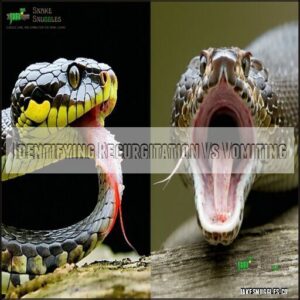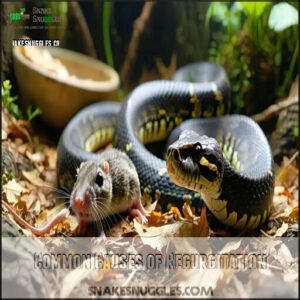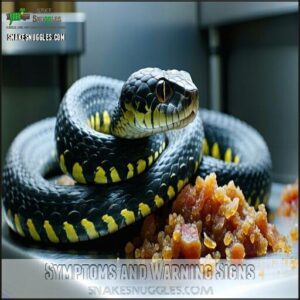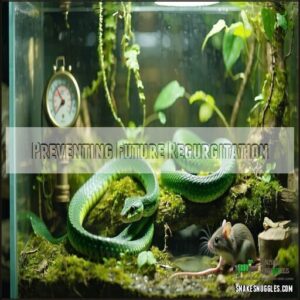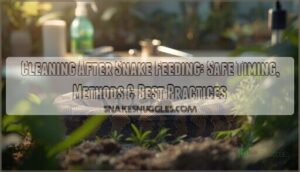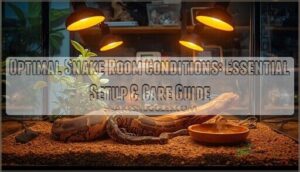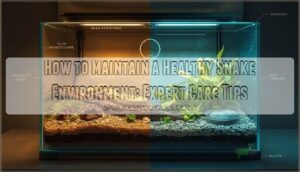This site is supported by our readers. We may earn a commission, at no cost to you, if you purchase through links.

First, check your snake’s environment. Stress, improper temperatures, or feeding prey that’s too large are common culprits.
Clean the enclosure thoroughly and give your snake a few days to rest. Minimize handling during this time to let them recover. Hydration is key, so make certain fresh water is available, but hold off on feeding until they’re back to normal.
If regurgitation keeps happening, or you notice weight loss or lethargy, consult a reptile vet. Prevention starts with proper husbandry—it’s better to address the roots than deal with repeat messes!
Table Of Contents
- Key Takeaways
- Recognizing Regurgitation Signs
- Handling Regurgitation in Snakes
- Immediate Care and Recovery
- Preventing Future Regurgitation
- Long-Term Health and Nutrition
- Frequently Asked Questions (FAQs)
- What should I do if my snake regurgitates?
- What is the difference between vomiting and regurgitation in snakes?
- Do all snakes regurgitate?
- How to tell if regurgitation requires vet care?
- What is the timeframe for refeeding after regurgitation?
- Are certain snake species more prone to regurgitation?
- Can stress from loud noises trigger regurgitation?
- Conclusion
Key Takeaways
- Check the enclosure’s temperature and stress levels since improper conditions often cause regurgitation.
- Give your snake a few days to recover without handling and provide fresh water to ensure hydration.
- Thoroughly clean and disinfect the snake’s enclosure to prevent infections and create a calm environment.
- Wait at least 14 days before feeding again and start with smaller, appropriately sized prey.
Recognizing Regurgitation Signs
You’ll want to spot the difference between regurgitation and vomiting quickly, as each signals different issues.
Regurgitation often occurs soon after feeding, with food coming up intact, while vomiting involves partially digested food and usually points to bigger health problems.
Regurgitation happens quickly with intact food, while vomiting shows partially digested prey and signals more serious health issues.
Identifying Regurgitation Vs Vomiting
Snake regurgitation and reptile vomiting may seem similar, but they’re quite different.
Regurgitation is passive, with mild contractions and undigested food expelled shortly after feeding.
Vomiting, however, involves forceful ejection of partially digested contents, often showing distress signs.
Food appearance varies: regurgitation features prey-like forms, while vomitus resembles stool.
Timing is key—regurgitation occurs quickly, vomiting later.
Examination of the vomitus offers clues about digestive stage and potential issues.
Common Causes of Regurgitation
Many snake regurgitation causes tie back to improper husbandry or health.
Look out for these triggers:
- Temperature issues: Cold enclosures disrupt digestion.
- Prey size: Overfeeding or large prey stresses the digestive system.
- Handling stress: Handling snakes less than 48 hours post-feeding leads to regurgitation.
- Husbandry practices: Poor enclosure setup or hygiene increases risk.
- Parasitic infections: Parasites like cryptosporidium often cause digestive upset.
Avoiding these guarantees better snake health.
Inadequate hiding spots can also cause stress induced regurgitation.
Symptoms and Warning Signs
Spotting regurgitation signs early can make a big difference in snake health.
Keep an eye out for behavioral changes like restlessness, frequent swallowing motions, or hiding after eating. Physical manifestations include expelled food that’s undigested, slimy, or prey-shaped.
Frequency matters too—if it happens repeatedly, investigate regurgitation causes. Severity levels vary, but consistent symptoms mean it’s time to act.
Addressing symptoms promptly supports snake regurgitation prevention and keeps your pet thriving, which is crucial for maintaining overall snake health and ensuring the pet is thriving.
Handling Regurgitation in Snakes
When regurgitation happens, knowing how to handle it makes all the difference. Start by addressing environmental triggers, as poor temperature and handling stress are common culprits. Watch for signs like regurgitated prey or clear distress—your snake depends on your attention.
Start by fixing the environment—temperature and stress are often to blame when your snake regurgitates. Stay attentive, they rely on you.
- Stop handling immediately to reduce esophageal damage.
- Ensure proper enclosure temperature for smooth digestion.
- Provide hydration to replace lost electrolytes and digestive enzymes.
- Prevent future stress by creating a quiet recovery space.
Handling it right minimizes fatal risks and promotes healing.
Immediate Care and Recovery
When your snake regurgitates, acting quickly is key to its recovery and long-term health.
You’ll need to focus on creating a clean, calm environment and providing gentle care to help your pet bounce back.
Cleaning and Disinfecting The Enclosure
After regurgitation, it’s time to clean and disinfect cages thoroughly.
Replace dirty substrate with fresh options like paper towels or aspen chips. Use reptile-safe disinfectants, such as F10 or chlorhexidine, and sanitize water bowls daily.
It’s important to use appropriate cleaning products to maintain a healthy environment. Follow strict hygiene protocols to prevent infections.
Task Frequency
Providing a Stress-Free Environment
To reduce snake stress after regurgitation, provide a proper enclosure with stable temperature, lighting needs, and a secure environment.
Minimize handling after feeding, and include quiet hides for privacy.
A stressed snake won’t recover well, so create a calm space.
Think of it as their spa retreat—low noise, no disruptions, and plenty of rest for healing.
Administering Probiotic Treatment
After cleaning the enclosure, use probiotics to support your snake’s digestive health.
Probiotic types like Nutribac can be dusted onto prey or mixed into water. Follow dosage guidelines carefully—less is more.
Many owners find snake probiotic products helpful for gut health.
A 14-day treatment duration helps restore gut bacteria and prevent future regurgitation. Snake probiotic treatment works best when the snake rests, aiding proper digestion and recovery progress.
Monitoring Symptoms and Hydration
Keeping an eye on your snake’s recovery means tracking its Symptom Timeline and watching for Dehydration Signs.
Look for wrinkled skin, lethargy, or sunken eyes. A key indicator is dry, wrinkled skin.
Follow these tips to maintain hydration:
- Offer fresh water daily.
- Use soaking bowls for extra Hydration Methods.
- Boost electrolytes with a vet-approved aid.
- Schedule Veterinary Checkups if symptoms persist.
Preventing Future Regurgitation
Preventing regurgitation in snakes starts with creating the right environment and feeding habits.
By maintaining proper temperatures, choosing appropriately sized prey, and limiting stress, you can keep your snake happy and digestion on track.
This approach ensures that the snake’s overall well-being is considered, leading to a healthier pet.
Maintaining Proper Temperature and Humidity
A steady temperature gradient is key to snake care.
Set a basking spot for digestion and keep nighttime heat consistent. Monitor humidity levels to prevent shedding issues and temperature-related stress.
Optimal humidity levels are essential for boa constrictors.
Poor conditions can trigger snake regurgitation, so use thermometers and hygrometers to stay on track.
Comfortable snakes? Less regurgitation. It’s a win for everyone, with proper care being the key.
Feeding Prey of Appropriate Size
A proper prey size guide matters for digestion efficiency and preventing snake regurgitation.
Overfeeding or offering prey bigger than the snake’s head can strain its system, causing issues.
Stick to single prey items rather than multiple prey items at once.
Choosing the right prey item type and size guarantees smoother snake feeding and keeps regurgitation risks at bay.
Minimizing Handling and Stress
Stress and over-handling can lead to regurgitation.
Set up quiet enclosures to keep your snake calm. If handling is necessary, use gentle handling with secure holds to avoid overloading them.
Gradual introduction to a new routine helps ease stress. Avoiding overstimulation, like loud noises or rapid temperature changes, is key to preventing snake regurgitation and promoting smoother digestion.
Avoiding overstimulation is crucial in maintaining the snake’s health.
Ensuring Proper Hygiene and Cleaning
After managing stress, focus on hygiene to keep regurgitation risks low.
Use the right disinfectant for the snake enclosure, replace the substrate regularly, and sanitize water bowls daily.
Spot cleaning prevents bacterial infections while a proper cleaning schedule guarantees healthy enclosure materials.
Remember, dirty spaces aren’t cozy—we wouldn’t sleep in them, and your snake shouldn’t either, as dirty spaces aren’t cozy, and this is crucial for maintaining a healthy enclosure.
Long-Term Health and Nutrition
Keeping your snake healthy after regurgitation means focusing on proper nutrition and gradual recovery. By reintroducing smaller meals, addressing deficiencies, and using supplements, you can support their long-term wellbeing.
Reintroducing Food and Nutrients
After regurgitation, your snake needs gradual refeeding to rebuild strength.
Start with a smaller meal, no bigger than 50% of its usual prey size. Use probiotics to boost digestive enzymes and support snake digestion.
Following a carnivorous nature is essential for proper diet.
Follow snake feeding guidelines closely, ensuring proper meal size for their recovery. It’s all about patience—small steps lead to better digestive health and fewer snake digestive issues.
Managing Nutritional Deficiencies
A snake’s digestive balance relies on gut flora, enzymes, and proper vitamin absorption.
After regurgitation, dietary adjustments support recovery. Offer food dusted with enzyme supplementation or probiotics to replenish what’s lost.
Electrolyte replacement helps fix dehydration, while following snake feeding guidelines reduces risks. Smaller, manageable meals are key—a bloated snake isn’t happy.
Stick to a balanced snake diet; vitamin C deficiency, though rare, can also impact snake health to avoid future digestive problems.
Promoting Overall Health and Wellbeing
When focusing on your snake’s wellbeing, prioritize a suitable enclosure with proper temperatures and hiding spots.
Offer enrichment activities that mimic natural behaviors. Regular checkups are key to spotting digestive problems early.
Keep hydration a high priority—this supports the shedding process and prevents issues tied to snake husbandry.
A balanced snake diet guarantees recovery from regurgitation and long-term health.
Using Supplements Like Nutribac for Support
For treating snake regurgitation, Nutribac is a game-changer. This probiotic supports digestive health and aids recovery.
Here’s how to use it:
- Dust small prey with Nutribac for easy digestion.
- Mix with water for syringe feeding.
- Use it regularly for long-term digestive support.
- Combine with ideal husbandry practices.
- Consult a vet for recurring issues.
Nutribac promotes snake digestive wellness and is essential for a healthy gut, which leads to a happy snake!
Frequently Asked Questions (FAQs)
What should I do if my snake regurgitates?
Give your snake a break—don’t handle it, and clean its enclosure thoroughly.
Avoid feeding for two weeks, keep temperatures stable, and use probiotics if needed.
Monitor closely, and consult a vet if symptoms persist.
What is the difference between vomiting and regurgitation in snakes?
Vomiting in snakes involves forcefully expelling partially digested food from the stomach, often signaling illness.
Regurgitation is more passive, expelling undigested food before reaching the stomach, typically caused by stress or husbandry issues.
Do all snakes regurgitate?
Not all snakes regurgitate, but it can happen if they’re stressed, handled too soon after eating, or exposed to improper temperatures.
It’s their way of telling you something’s off—so, always double-check their care conditions.
This is their natural response to stress, and it indicates that something is wrong with their environment.
How to tell if regurgitation requires vet care?
Watch for repeated regurgitation, weight loss, dehydration, or unusual behavior like lethargy.
If regurgitation follows proper care adjustments or includes blood, visit a vet promptly—it’s better safe than sorry regarding your snake.
What is the timeframe for refeeding after regurgitation?
Ever wonder how long to wait before offering food again?
Give your snake at least 14 days to recover.
This break guarantees proper digestion and reduces stress for smoother feeding later.
Patience pays!
Are certain snake species more prone to regurgitation?
Certain snake species, like ball pythons and boas, can be more prone to regurgitation due to stress, improper husbandry, or specific health conditions.
Factors like their natural behaviors and sensitivities make them more susceptible to regurgitation.
Can stress from loud noises trigger regurgitation?
When life gets noisy, snakes can feel the tremors too.
Stress from loud sounds may disrupt their calm, triggering regurgitation.
Keep their environment serene, like a library, to avoid unsettling their digestive process.
Conclusion
Imagine your snake regurgitating right after a meal—it’s unsettling, but manageable.
Understanding how to handle regurgitation in snakes begins with pinpointing the cause, whether it’s stress, improper temperature, or oversized prey.
Clean their enclosure, provide rest, and make certain they’re hydrated. Avoid feeding again too soon, and consult a reptile vet if it persists.
Prevention is key, so focus on proper husbandry: ideal temperature, the right prey size, and reduced handling. With care, your snake will recover smoothly.

